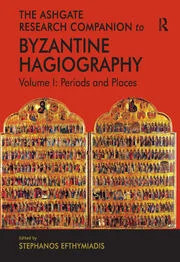Stephanos Efthymiadis, whose Hagiography in Byzantium: Literature, Social History and Cult appeared in 2011 (Ashgate), has headed up an international team of 28 experts to produce this unprecedented landmark in Byzantine studies. Written for both the specialist and graduate students, it will serve its readers well, with the usual caveat that a publication of this kind is out of date as soon as it is printed (for the tide of academic books and articles on Byzantine and especially hagiographic studies is a never ending one), for the next few decades. Even with this caveat, however, Efthymiadis and his team point the way, as the stated aim of the volume reads, ‘to function as a vademecum, a guide, which will incite further in-depth study of texts, authors, periods and languages in their chronological, geographical and typological diversity and expansion’ (11).
Volume One, dealing with Periods and Places, covers the authors and texts of the four major periods during which Greek Byzantine hagiography developed, and then the hagiography written in Oriental and Slavic languages and geographical regions around the empire. Volume Two, dealing with Genres and Contexts, explores the wealth of literary dynamism and the variety of basic forms in which hagiography was produced, beginning in the fourth century and ranging down principally to the fifteenth (and beyond in some cases), as it interfaced with changes in the political and social, in addition to the literary, spheres.
In its Introduction (Efthymiadis) and fourteen chapters, Periods and Places authoritatively examines, first, hagiography in the fourth-seventh, eighth-tenth, eleventh-twelfth centuries, and late Byzantium (1204-1453), and, second, the ‘Byzantine Periphery’: Palestinian, Italo-Greek, Syriac, Georgian, Armenian, Coptic, Arabic, and Slavic hagiography, and translations into Greek of Latin hagiographical works. This volume adequately covers an exceptionally wide linguistic, chronological, and geographical range of material on countless holy men and women. Whilst handling of individual saints is necessarily brief, the contextual settings of each chapter are invaluable, and all are completed with comprehensive bibliographies of primary and secondary sources. There are indices of Greek words and of manuscripts cited in addition to a General Index.
Genres and Contexts, in its new Introduction (Efthymiadis) and 16 chapters, presents state-of-the-art studies of current research in three areas: Genres, Varieties and Forms, Hagiography as Literature, and Hagiography and Society. Part One includes essays on Greek Passions, Miracles, Edifying Stories, Verse Form and Synaxaria, and there is a chapter on Symeon Metaphrastes and the Metaphrastic movement. The next part looks at the Hagiographer and his Text, Audience, Language and Patronage, the interrelationship between Hagiography and Hymnography, Fiction and/or Novelisation, Actors, Fools and Cross-Dressers, and the Literary Portrait of Byzantine Female Saints. The final part considers Economy and Society: Realia and Methodological Questions, The City, and the Hagiography of Doubt and Scepicism.
Whilst handling of individual saints is necessarily brief (especially in the first volume), the contextual settings of each chapter throughout the pair of volumes are invaluable, and all are completed with comprehensive bibliographies of primary and secondary sources. In addition to a General Index, there are indices of Greek words and of manuscripts cited for each volume.
In my review of Hagiography in Byzantium I had cause to write, ‘an interesting read by a young scholar who has already carved out an impressive place for himself in Byzantine studies.’ His present publications enhance his place and Byzantists the world over owe him a tremendous debt for such eminent volumes.

